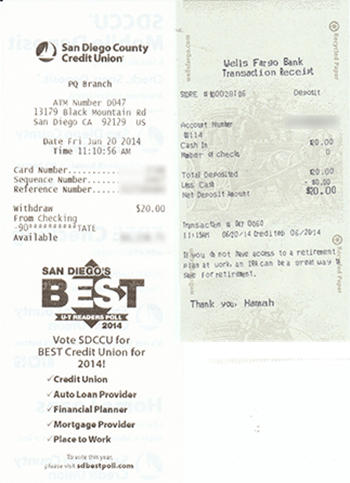Most of our work with banks focuses on scanning checks and swiping cards, but today let’s take a moment to focus on another, equally important part of the teller transaction process: printing receipts. A receipt printer is a pretty utilitarian device, and most people ”” bankers and retailers alike ”” look at it as something that you buy once and then forget about for 10 or 15 years, until it either wears out or has to be replaced for compatibility reasons.

TWO BANK RECEIPTS show examples of thermal printing, left, and dot-matrix printing on standard paper, right. The thermal device prints the logo at top and bottom each time, while the dot-matrix device uses text only. The pre-printed background on the dot-matrix paper makes use of more elaborate patterns and shading, but adds to the cost of the paper. |
That may be true for the most part, but what often goes unnoticed is that the $100-$300 you’ll spend for a reasonable-quality receipt printer is just the first drop in the bucket. If it gets even moderate use, you can expect to spend somewhere between $2,000 and $6,000 on ink and paper. Just how much depends a lot on what kind of printer you use, with most devices falling into one of three categories: Dot-matrix, Inkjet, and Thermal.
Without going into too much detail, the main differences between the three are:
- Dot-matrix printers use ribbons, which are cheap but must be replaced frequently; they are also the slowest.
- Inkjet printers are faster and their cartridges last up to several times longer, but also cost more than ribbons.
- Thermal printers are faster still and require no ink; however, thermal paper costs slightly more than regular paper.
We recently posted an educational page with a cost comparison between ink and thermal printing, along with cost calculators for ink.
There’s one other small difference that’s become important in the battle between thermal and ink: the use of company logos on receipts. As it turns out, this is a key factor in the cost of paper, and tips the break-even point in favor of thermal if you want your receipts to have a distinctive look. Ordinarily, plain receipt paper can be had for as little as 40 cents per 150-foot roll, while thermal paper comes in longer rolls (220 or 230 feet) that cost around 80 cents – so you get 25-30% more paper for your dollar with the standard variety.
Here’s the catch ”” that’s for plain white paper, with no decorations, which means you’ll be printing out text-only receipts. That’s probably OK for small businesses, but most larger companies tend to want receipts with a distinctive look, usually including a logo. For that, there exist two options: Have it pre-printed on standard paper, which can almost double the cost per roll; or use thermal paper and print the logo on each receipt, which doesn’t add any extra cost in either paper or ink.
There’s actually a third option, but it isn’t a very good one: Use standard paper and have the dot-matrix or inkjet device print the logo on each receipt as it goes. Why is this practical with thermal, but not with ink? Partly because of the cost ”” using this method consumes significantly more ink, whereas with thermal, it’s free ”” but mainly because of practical concerns. With a dot-matrix printer, that means speed and quality: Printing a logo line-by-line on each receipt would slow down the machine considerably, and many dot-matrix devices are limited in what they can do graphically. Inkjets can do the job faster, but creating a large, often heavily printed pattern in wet ink, even if only briefly, can present challenges.
Thermal faces none of these problems, with no speed loss, ink use or drying time to contend with. So whenever it’s time to replace your countertop hardware, take a moment to sit down and figure out what you need, not only in terms of equipment, but also the way you want your receipts to look and feel. You might save yourself hundreds of dollars and look good doing it.





